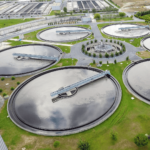
The European Green Deal: Global Objectives and Impacts in the Livestock Sector
24/01/2025
Biotechnological solutions for Wastewater treatment: Functional Solutions for a Sustainable Future
21/02/2025Biogas production represents one of the most sustainable solutions for energy recovery from organic materials, contributing to a significant reduction in environmental impact. However, the efficiency of this process depends not only on the quality of the biomasses used, but also on the microbiological balance that drives anaerobic digestion. In this context, biotechnological additives play a crucial role: thanks to their ability to optimize the biological conditions inside the digester, they promote a higher energy yield and a more sustainable management of resources. Let’s explore the potential of these biotechnologies and their impact on the entire biogas production cycle.
Biomasses
Biomasses are one of the primary sources for renewable energy production and are derived from a variety of organic materials.
Agricultural By-products
These include residues resulting from the harvesting and processing of crops, such as straw, corn stover, shells, and peels. Often considered waste, these materials find a second life in the production processes of biogas and/or biomethane or as fuel for wood biomass plants. Their valorization helps reduce the environmental impact of agricultural activities and closes the nutrient cycle.
Energy Crops
These are plants cultivated specifically for energy production. Among the most common are corn, sorghum, triticale, and miscanthus, grown for their high biomass yield per hectare. These crops are particularly valued in biogas plants for their high anaerobic digestibility, which guarantees a stable methane production. However, their use raises debates about competition with food production and sustainable land use.
Manure
Manure and slurries, rich in organic matter and nutrients, primarily come from livestock farming and represent an important resource for biogas production. Their anaerobic digestion not only generates energy but also helps reduce greenhouse gas emissions such as methane, which would otherwise be released into the atmosphere during natural decomposition. Additionally, reuse of manure and slurries in anaerobic digestion plants ensures better nitrate management. The digestate produced as a by-product can be used as a natural fertilizer, contributing to more sustainable agriculture.
Agro-industrial By-products
These include materials derived from the industrial processing of agricultural products, such as fruit wastes, grape marc, pomace, whey, and waste oils. These residues, often abundant and concentrated during specific periods of the year, offer a high energy yield due to their chemical composition rich in sugars, fats, and proteins. Treating these by-products in anaerobic digesters is an effective solution to reduce disposal costs and minimize the environmental impact of the agri-food industry.
Industrial Sludges
Industrial sludges are residual organic materials derived from the wastewater treatment processes of industrial sources (e.g., food industries, dairies, wineries, breweries, distilleries, sugar factories, slaughterhouses, paper mills, tanneries, etc.). Often rich in organic substances and nutrients, these sludges can be used as biomass for biogas production through anaerobic digestion. Their energy valorization represents a sustainable solution to reduce the environmental impact of disposal and decrease the volume of waste sent to landfills, contributing to the recovery of energy and nutrients.
Urban Sludges
Urban sludges come mainly from the treatment of domestic wastewater in sewage treatment plants. They represent a stable and homogeneous biomass with a high organic matter content, which can be used in anaerobic digesters for biogas production. This process allows for energy recovery and reduces the environmental impact of traditional disposal methods, promoting a more sustainable management of urban resources.
FORSU
The Organic Fraction of Municipal Solid Waste (FORSU) represents the organic waste derived from separate collection, such as food scraps and plant residues. Thanks to their high content of easily biodegradable organic matter, these wastes are particularly suitable for anaerobic digestion, which produces biogas and high-quality compost. Valorizing FORSU contributes to reducing the amount of waste destined for landfills and incinerators, promoting a circular and sustainable economy.

Challenges During Production, Processing, and Fermentation
The production and treatment of biogas are not without operational challenges that can compromise plant efficiency. Among the most common issues are:
Undesirable Compounds: One of the main problems is the presence of hydrogen sulfide (H₂S), a toxic and corrosive gas generated during anaerobic fermentation, especially when processing sulfur-rich materials. H₂S not only poses a safety risk but can also severely damage metal components of the plant (such as engines, pumps, pipes, and other metal parts), accelerating their wear. Managing this gas requires specific interventions—like using filters or chemical additives to reduce the sulfur content in the produced biogas—but it can be significantly minimized preventively by optimizing the digester’s biological processes.
• Foam and Crust Formation: Another frequent issue is the formation of foam and crusts inside the digester. These phenomena can be caused by an excess of fats, proteins, or surfactants in the incoming biomasses, which disturb the balance of the biological process. Foam hinders the release of biogas, reducing overall efficiency, while solid crusts on the surface of the digestate can block or damage the agitators, slowing down mixing and creating stagnant zones within the digester. These problems require constant maintenance, which increases operating costs and plant downtime.
• Mechanical Blockages: Obstructions and mechanical blockages, caused by the accumulation of fibrous materials or improper management of the organic load, are another source of inefficiency. Clogging of pumps, pipes, or heat exchangers can interrupt the flow of materials, necessitating manual cleaning operations or plant shutdowns for the replacement of damaged components. These blockages not only reduce productivity but also represent a significant economic loss.
• Underutilization of Biomass Potential: A less visible but equally critical issue is the failure to fully exploit the potential of the biomasses. In many cases, the composition of the incoming biomasses is not optimized or adequately treated to maximize biogas and/or biomethane yield. High-energy residues, such as oils or fats, may be underutilized, while inefficient mixing or inadequate control of biological parameters (pH, temperature, retention times) can limit the digester’s ability to completely degrade the organic matter. This waste reduces biogas production and compromises the economic and environmental balance of the plant.
Measures for Effective Production and Preventive Optimization
A Balanced Supply of Microorganisms Ensures an Optimal Process
A balanced supply of microorganisms is essential to guarantee a stable and efficient anaerobic digestion process. Anaerobic digestion—from the degradation of feedstocks to the production of biomethane—depends not only on the incoming substrates and nutrients but also on microorganisms essential for synthesizing enzymes and coenzymes that catalyze fundamental biochemical reactions.
An improperly balanced microbial community can slow down metabolism, leading to undesirable effects and a lower biogas yield. Furthermore, microbial imbalances may favor less efficient microorganisms and increase the production of toxic and harmful gases like H₂S.
Maintaining the Right Nutritional Balance is crucial
The biodigester functions like a living organism, with internal balances that constantly vary. Therefore, it is important to follow a “balanced diet” by monitoring changes and fluctuations. The line between optimal nutrient supply and toxicity is very thin, making it crucial to closely monitor nutrient concentrations through precise chemical analyses.
A constant supply of beneficial microorganisms can help mitigate biological imbalances.
Increasing Yield and Fully Exploiting the Potential of Biomasses
Specific products, such as microbiological additives, can:
- Improve Bacterial Activity: Enhance bacterial activity within the biodigester, thereby making the anaerobic digestion process more efficient.
- Stabilize Reactor Conditions: Help stabilize the reactor conditions, reducing management costs.
- Boost Biogas Yield: Increase both the qualitative and quantitative yield of biogas by optimizing the ratio between the treated by-products/waste and the biogas produced.
- Optimize Hydraulic Retention: Better exploit the residual potential of the biomasses during the hydraulic retention period.
EnzyVeba® Biomethane is a complex symbiotic mixture of proprietary fungi and bacteria, provided in the form of a natural and completely biodegradable liquid. The microorganisms in the product are capable of carrying out hydrolytic, acidogenic, and acetogenic activities—that is, they catalyze the breakdown of complex molecules such as cellulose, lignin, fats, and starches into simpler compounds like alcohols and volatile fatty acids. Other microorganisms in the mixture, which perform methanogenesis, then convert these compounds into methane, carbon dioxide, and water. Some of the genera present in EnzyVeba® Biomethane include Bacillus, Methanobacterium, Moorella, Methanosarcina, Methanosaeta, and Methanococcus. The presence of mesophilic, thermophilic, and psychrophilic species allows the product to work effectively over a wide range of temperatures and in all systems or phases of the process.
This results in the ability to:
- Biodegrade Complex Matrices: Break down complex substrates—including lignin, hemicellulose, cellulose, and keratin—ensuring efficient digestion even of recalcitrant substances.
- Control Critical Parameters: Maintain control over critical parameters such as pH, ammoniacal nitrogen, and hydrogen sulfide, thereby improving the quality of the produced biogas.
- Optimize Hydraulic Retention Times: Make the digestate more suitable for field application by optimizing hydraulic retention times.
- Reduce Chemical Use and Operating Costs: Minimize the use of chemicals and reduce operating costs by making the processes more efficient.
- Save Electrical Energy: Improve the fluidity of the digestate, reducing the agitation times of the mixers and saving electrical energy on self-consumption.
Conclusion
Biodigesters, along with the production of biogas and biomethane, represent a strategic solution to address the challenges of sustainability and the energy transition. Investing in this technology means transforming waste and organic by-products into valuable resources, promoting the production of renewable energy and gas, and actively supporting the circular economy.
With the continuous development of innovative technologies and optimized solutions to increase biomethane yield, the role of biodigesters is set to become increasingly central—paving the way for a more sustainable and responsible energy future.
If you are looking for solutions to improve the efficiency of your plant and maximize biogas and/or biomethane production, Paneco Ambiente’s innovative technologies can make a difference. The future of green energy is here, and it goes through biodigesters.













